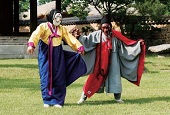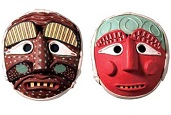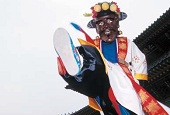- 한국어
- English
- 日本語
- 中文
- العربية
- Español
- Français
- Deutsch
- Pусский
- Tiếng Việt
- Indonesian
Mask dances: Evoking an Intrinsic Sense of Joy
2. Types and Characteristics of Traditional Korean Mask Dances
Mask dances performed as part of shamanic rituals, or seonanggut talchum
The Hahoe Byeolsingut Mask Dance is a mask dance performance handed down in the village of Hahoe, near Andong, North Gyeongsang Province. It is typical of mask dances performed as part of shamanic rituals to pray for the wellbeing of the village and a bountiful harvest.
Since ancient times, people have put their faith in their local guardian gods. The residents of Hahoe similarly undertook sacrificial rites in honor of their guardian deity. The word byeolsingut refers to a special shamanic ritual held once every five or ten years, rather than annually.
The following story is about the origins of the masks used for this particular Hahoe mask dance.
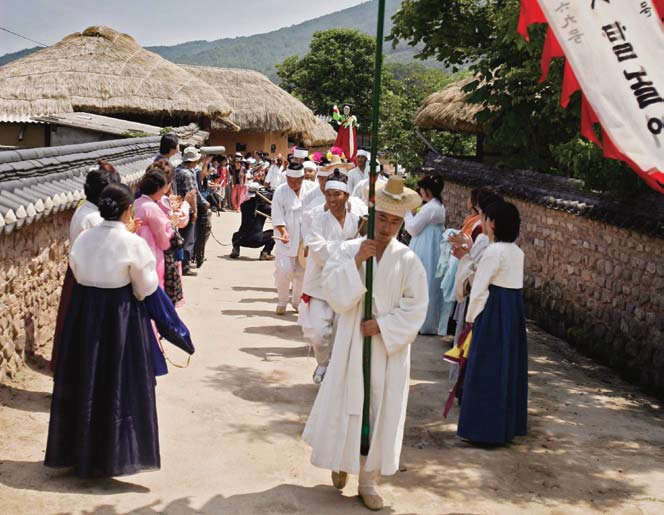
Musicians and clowns participate in the pre-show parade for the Hahoe shamanic mask dance.
In the middle of the Goryeo Dynasty (918-1392), there lived a craftsman, who went by the name Heo. For years his village suffered from constant misfortunes but no one knew why.
One day, Heo dreamt about a mountain god and received an oracle message that the misfortunes would disappear if the villagers danced with masks made by Heo. The god said Heo was not to have any contact with anyone until he finished. Awaking from his dream, Heo could not ignore the instructions. He had a straw rope wound around his workshop to allow him to work undisturbed by others and immediately set to work making the masks.
At long last, one hundred days had passed. A young woman named Kim was in love with Heo and was growing weary of waiting. She broke her vow to leave him undisturbed for one hundred days and peeked into her lover’s workshop to see what he was doing. He was carving the last mask, that of the scholar's foolish servant, Imae. The moment she glanced inside, Heo collapsed spitting blood and died. The mask was left unfinished.
Out of guilt for causing his death, the young woman committed suicide. Afterward, the residents of Hahoe village decided to serve the dead woman as a tutelary god and held annual rituals to assuage her soul.
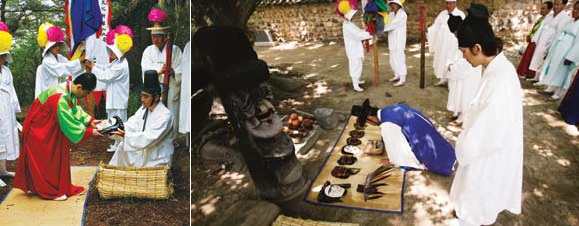
(Left) A rite is performed to hand over the masks to the clowns; (right) Mask rites take place at a shrine.
This is the myth behind the masks and the shamanistic ritual as passed down in the village of Hahoe.
Why did the broken hearted young woman become a guardian deity of Hahoe village?
There is a common saying around the world, also treasured by people here, that “Hell hath no fury like a woman scorned.” The residents of Hahoe village did not want evil spirits bringing illness and bad luck to set upon them by the dead woman. They held sacrificial rites to appease the soul of the broken-hearted woman and to ask her to protect the village from evil spirits.
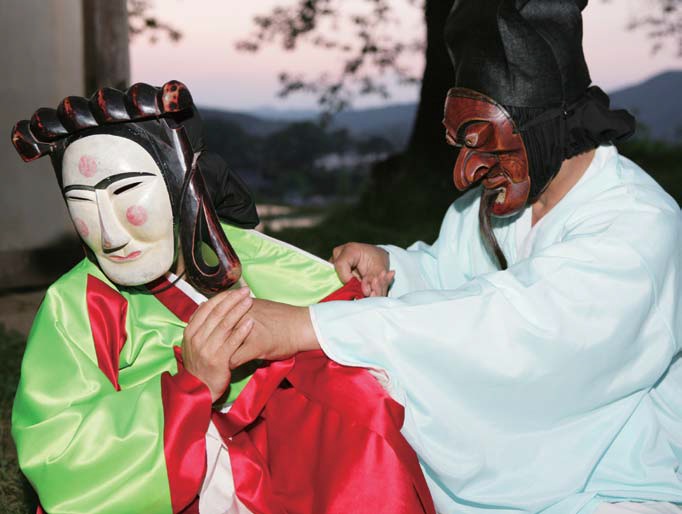
A scene from the bridal chamber episode of the Hahoe shamanic mask dance.
The shamanic mask dance from Hahoe has been performed as part of shamanic rituals and thus the dance features distinctive shamanic characteristics. The basic content and themes are not particularly different from those of other mask dance performances, but the Gaksi character, personifying the guardian deity of the village, plays a more important role in the mask dance drama.
The Hahoe shamanic mask dance consists of eight scenes, among which the wedding scene, or honrye scene, and the bridal chamber scene, or shinbang scene, are performed separately after the previous six episodes have been concluded and the audience returns home. The final two scenes and the first dance scene by Gaksi, the mudong, serve as a ritual to assuage the guardian deity, who died a virgin. These three scenes can only be found in this town's mask dance performance.
Hahoe's shamanic mask dance is one of the oldest mask dances known in Korea. The Hahoe masks also boast their own long history. While most masks were burnt immediately after a performance, the Hahoe masks were protected in the village shrine. This has enabled them to last until today exactly as they were first created during the Goryeo Dynasty period.
The Hahoe mask dance features eleven characters: the bride, or gaksi, the nobleman, or yangban, the scholar, or seonbi, the flirty young woman, or bune, the Buddhist monk, or jung, the butcher, or baekjeong, the old woman, or halmi, and the nobleman's servant, or choraengi. There are also two lions, the juji, and the half-finished mask for the scholar's foolish servant, or imae.
The Hahoe masks are aesthetically valuable as wooden sculptures, too. Each has distinctive characteristics and was cut elaborately to allow changes in facial expression according to the movements of the performers.
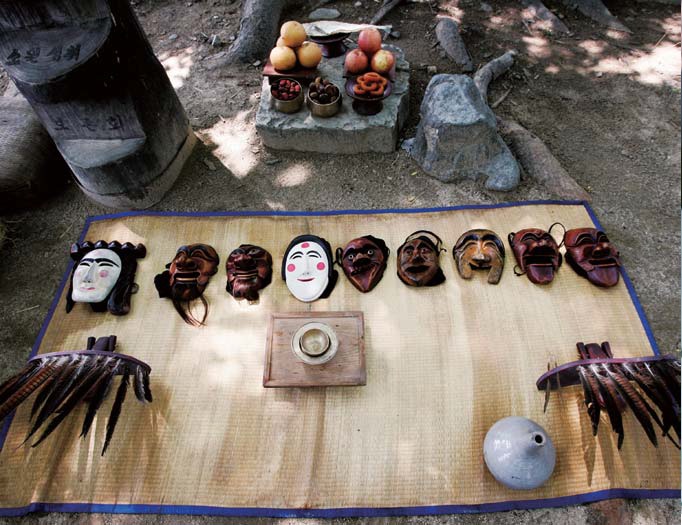
The mask rite at the Samsindang shrine.
The foolish servant mask, or imae
Legend has it that a young man named Heo carved this mask as the final piece but was unable to finish it. As a result, the mask has been handed down missing the jaw. With a cleft lip and crooked nose, the mask is for the foolish servant character in Hahoe's shamanic mask dance. He does not lose his smile, despite constant ridicule.
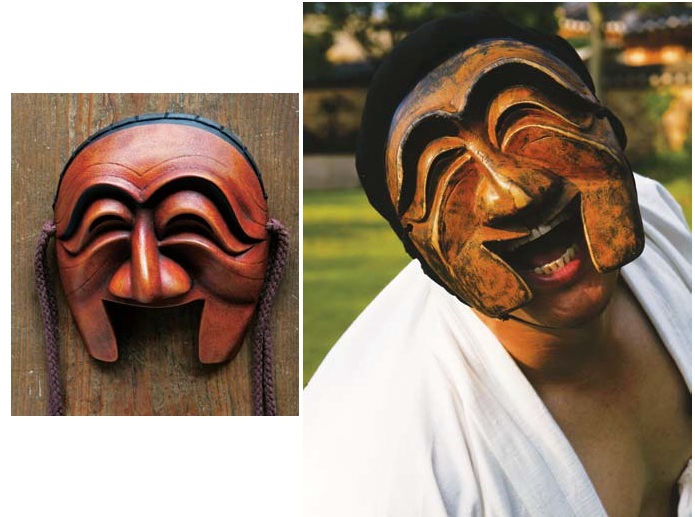
(Left) The foolish servant mask from Hahoe's tradition of shamanic mask dances; (right) Its lower jaw is unfinished. Long drooping eyes make the face look foolish.
The servant mask, or choraengi
The nobleman's servant plays a similar role in other mask dances. The crooked mouth and severed nose of the mask represent the situation in which commoners were not allowed to voice their complaints under the strict social system. In the play, however, the servant pokes fun at his arrogant master to his heart’s content, surpassing the limits of his lowly status.
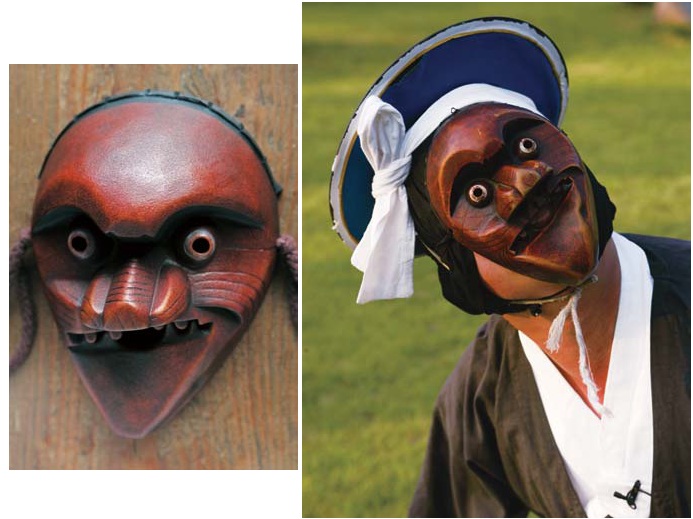
(Left) The nobleman's servant mask is part of Hahoe's shamanic mask dances; (right) The nobleman's servant speaks for all members of the lower classes.
Masks from Hahoe's shamanic mask dances
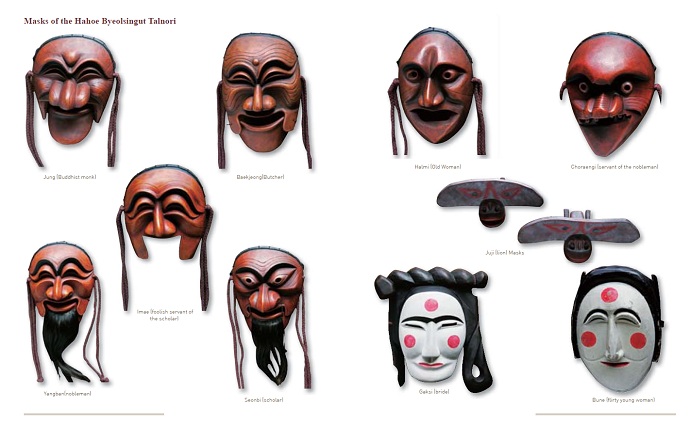
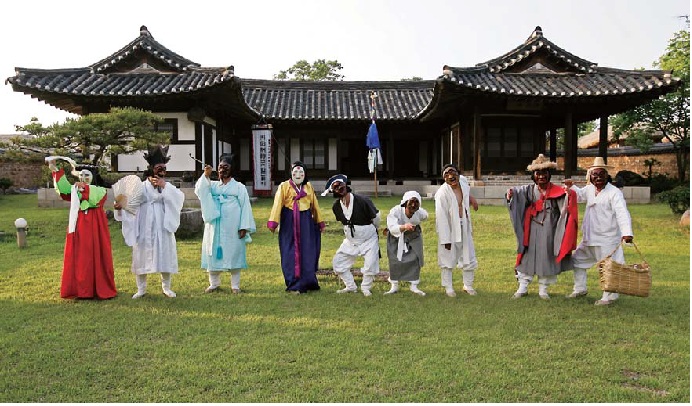
All of the nine masks from Hahoe's shamanic mask dance feature unique facial attributes and their own individual names and roles.
*This series of article has been made possible through the cooperation of the National Research Institute of Cultural Heritage. (Source: Intangible Cultural Heritage of Korea)
